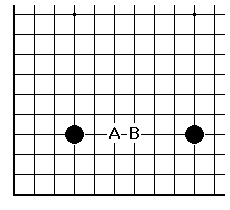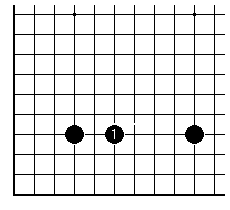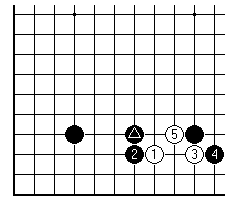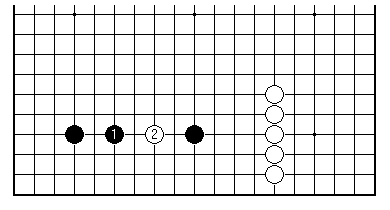

Unnaturally quiet for a while, you eventually bring me another type of query.
"So, there are things about Go you can just know. You've shown me a few, and I appreciate it. There are other things that are debatable, and I'll accept that one can get on and play without all the answers. But I sense that there is some sort of overarching framework that the strong players round here have in common - their discussions use technical vocabulary I've not heard, but the degree of consensus seems remarkable. After all, there are literally millions of variations you could go over. So, what's the quickest way in to the overview?"
Well, I'm not sure I want to attempt a one-line answer to that. It's a bit like the classic "how do I get from 4 kyu to 1 dan overnight?" That's the difference between taking yourself seriously as a player, and others according you the same respect. You can get the vocabulary out of books, but simply throwing the jargon around isn't going to be a lot of help. And don't be fooled by the polite tone of the post-game discussions. I'm glad it has struck you, on the point of manners. Very often, though, the loser is sitting tight, waiting for the winner to finish explaining how it all went according to plan. This is even more galling when you had a perfectly good position and threw it away, which is common enough. All you can then do is to hope that, against human nature, you learn something more from the experience than how painfully easy mistakes are to make.
But let's get back to books. Your question is really coded language for "how do I study, rather than just play?" No, don't deny it. You're not short of opponents here.
Most of the Go books in the world, and the bibliography in the oriental languages is huge, are offshoots of some kind of journalism. Newspaper columns and magazines devoted to Go need filling, and the genres of game commentaries and technical articles mostly reflect the imperative to say something interesting, and of the right length. If you pick up a book written in this way, either you find it at your level and derive some pleasure and instruction; or it leaves you cold, doing you little good and less harm. The overall point of view arrives by some kind of osmosis.
The early days of Go books in English were marked by a realisation that this type of literature exists to meet a demand already present; it is hardly likely to create it. Some sterling work was done in founding a didactic literature more to western tastes. As soon as it reached beyond opening variations and life-and-death problems, which are close to being purely informative in content, there were expository problems. These were solved piecemeal, for example by the gradual reduction of Japanese technical terms to the hard core that do not translate in any simple-minded way. There are some rough edges and residual problems still attributable to that era (and a sight too much fundamentalism about things read in books), but on the whole a great job of ground-clearing was done. (A representative read is "Strategic Concepts of Go" by Nagahara, which might go some way to answer your initial question; but this isn't a beginner's book.)
It ought to be said, however, that once you have found out from a responsible source what the basic high-level concepts are, well enough to recognise them, that's just the start of the problem. Imagine the steel girder framework of a building: without the further additions of walls and roof, essential services and furnishings, it's really not much of a home. So it is with Go study, where the crisp organisation of knowledge about the game is essential, but in itself nothing like sufficient.
To give some concrete (even reinforced) examples, let's look at "framework", the Go concept (accepted equivalent these days of the Japanese moyo). The basic idea is of incomplete territory: an area you control but not so strongly that you can prevent all invasions. Such frameworks arise in just about every game, and have a life cycle of creation, followed by possible expansion, then either consolidation into definite territory, or invasion with subsequent fighting. The sheer variety of shapes and sizes in the frameworks that come up shows the need for some sort of theory (and incidentally exemplifies the richness of Go).

So, let's go over one of GOLD's basic lessons in this area. Here Black's two stones definitely constitute a framework, rather than anything else: White can come in both at the corner 3-3 point, or on the side between the stones. Consider how Black should play to develop this framework, choosing only out of A and B. That is, we narrow down to the case where the overall situation indicates that Black should start to consolidate, rather than (for example) expand up the left side.

The correct answer is A, with some qualification. Other things being equal, Black should favour the corner territory, over the side. As it is, White can still invade the corner at the 3-3 point (though this has become somewhat harder), and can break into the side. So was this all wasted effort on Black's part? Certainly not. With one further play the corner can be made a substantial, safe territory (the 3-5 point is normally best for that purpose). And in the mean time Black will have the advantage of numbers in any fight that breaks out around here.

More often than not the answer given is B (marked stone). It perhaps seems to link Black's stones up more definitely. That way of thinking reveals a defensive tendency. Unless that's appropriate in context, B is not typically best. As the diagram shows, there is still plenty of trouble White can dream up around here.

The quibble that should be added is about positions that are schematically of this kind. Suppose White has some substantial strength along to the right. Then Black 1 has the disadvantage that White 2 will give Black a weak group (eyeless stone) on the side, as well as White. In this case answer B should turn out better.
These are typical points about framework play. Go is very much a strategic game. Seeing why and how involves detailed understanding of some abstract concepts and the way they apply in game situations.
First published 1 June 2000 as On Your Side on MindZine,
Go Learning
© Charles Matthews 2000.